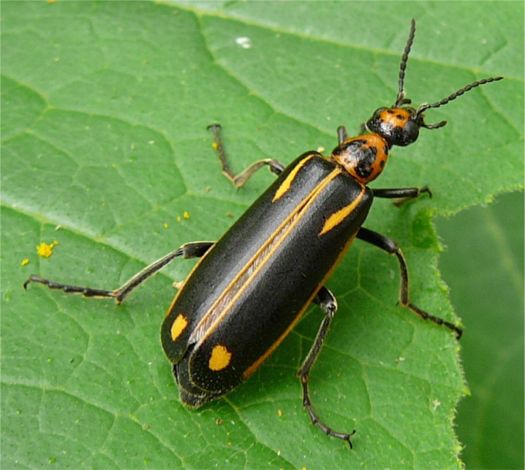
|
Return to Texas Entomology - Compiled by Mike Quinn
cf. P. palpalis, P. tenuicostatis

|
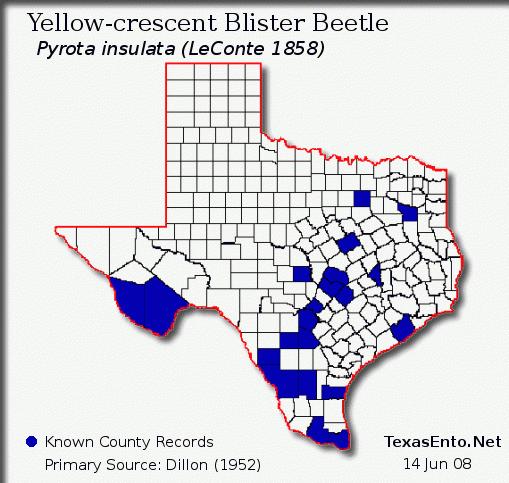
|
Primary County Record Source: Dillon (1952)
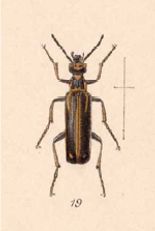 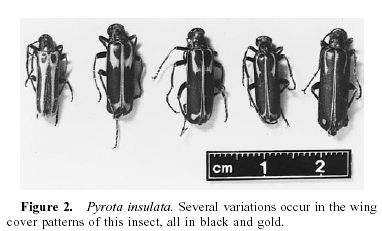
|

|
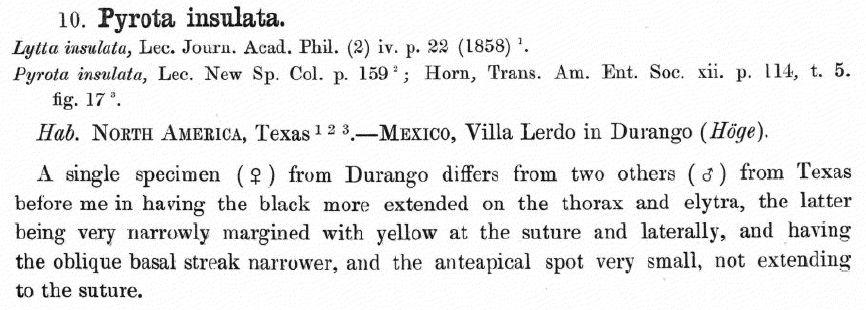
|
Fig. 2: Barr et al. 1998; all else: Champion 1889-1893
Range: Arizona to Texas, north to Wyoming, south to Durango, Mexico.
Flight Period: Begins as early as late February in lower Rio Grande Valley, flies in April and May further north in Texas.
Adult Food: Mainly the blooms of mesquite trees.
Biology: Attracted to lights, occasionally in large numbers
Similar Species:
There are 40 species of Pyrota restricted to the New World, about 30 in Nearctic.
Texas Taxa:
Pyrota akhurstiana Horn
Pyrota bilineata Horn
Pyrota concinna Casey
Pyrota deceptiva Selander
Pyrota discoidea LeConte
Pyrota fasciata Selander
Pyrota insulata (LeConte)
Pyrota invita Horn
Pyrota lineata texana Dillon
Pyrota mylabrina Chevrolat
Pyrota palpalis Champion
Pyrota perversa Dillon
Pyrota plagiata (Haag-Rutenberg)
Pyrota postica LeConte
Pyrota punctata Casey
Pyrota riherdi Dillon
Pyrota tenuicostatis (Dugès)
Pyrota victoria Dillon
Type Specimen: Lytta insulata LeConte, 1858 - Harvard, MCZ
Type Locality: Texas
Weblinks:
Blister Beetles - Bart Drees & John Jackman, 1999.
Blister Beetles - Featured Creatures - Richard B. Selander & Thomas R. Fasulo, 2003.
Etymology: Pyrota insulata (LeConte 1858)
pyro, (G). Fire; wheat
insula (L). An island
Biography:
John LeConte (1825-1883) - University of Nebraska-Lincoln State Museum
John Lawrence LeConte (1825-1883) - Wikipedia
References:
Arnett, R.H., Jr., M.C. Thomas, P.E. Skelley & J.H. Frank. (editors). 2002. American Beetles, Volume II: Polyphaga: Scarabaeoidea through Curculionoidea. CRC Press. 861 pp.
Barr, A.C., W.L. Wigle, W. Flory, B.E. Alldredge, J.C. Reagor. 1998. Cantharidin poisoning of emu chicks by ingestion of Pyrota insulata. Journal of Veterinary Diagnostic Investigation 10(1): 77-79.
Blackwelder, R.E., 1946. Checklist of the Coleopterous insects of Mexico, Central America, the West Indies, and South America, part 4. Smithsonian Institution US Natural History Museum Bulletin 185, Parts 1-6. 1492 pp.
Borror, D.J. 1960. Dictionary of Word Roots and Combining Forms. National Press Books, Palo Alto. v + 134 pp.
Brown, W.D., R. Standford. 1992. Male mating tactics in a blister beetle (Coleoptera: Meloidae) vary with female quality. Canadian Journal of Zoology 70:1652–1655.
Champion, G.C. 1889-1893. Insecta. Coleoptera. Heteromera (part). In: F.D. Godman & O. Salvin (editors). Biologia Centrali-Americana: or, contributions to the knowledge of the fauna and flora of Mexico and Central America. Taylor & Francis, London. 4(2): x + 494 pp. Tab. 21, Pg. 429, Pg. 434.
Dillon, L.S. 1952. The Meloidae (Coleoptera) of Texas. American Midland Naturalist, 48(2): 330-420.
Drees, B.M. & J. Jackman. 1999. Field Guide to Texas Insects. Taylor Trade Publishing, Lanham, MD. 376 pp.
LeConte, J.L. 1858. Descriptions of new species of Coleoptera, chiefly collected by the United States and Mexican boundary commission, under Major W.H. Emory, U.S.A. Proceedings Academy of Natural Sciences of Philadelphia 10: 59-89.
Pinto, J.D. & M.A. Bologna. 1999. The New World genera of Meloidae (Coleoptera): a key and synopsis. Journal of Natural History 33: 569-620.
Selander, R.B. 1983. A revision of the genus Pyrota. IV. The Tenuicostatis group (Coleoptera, Meloidae). Journal of the Kansas Entomological Society. 56 (1): 1-19.
White, R.E. 1983. A Field Guide to the Beetles of North America. Houghton Mifflin Company, Boston. 368 pp.
12 Mar 2010 © Mike Quinn / entomike@gmail.com / Texas Entomology / Texas Beetle Information